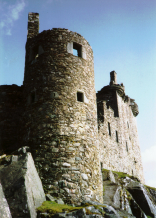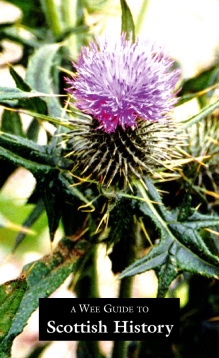Later Stewart Monarchs
1544-50 The Rough Wooing & Hertford’s Invasions
Struggles followed the death of James: between Mary of Guise, who supported the French, and the Hamilton Earl of Arran, Governor until 1554, who supported the English.
A treaty had been signed with the English that Mary, Queen of Scots, was to marry Edward, son of Henry VIII – but the Scots broke the agreement. In revenge, the south-east of Scotland was ravaged by the English, including the sacking of the abbeys at Melrose, Jedburgh, Dryburgh and Holyrood; castles; and villages – 243 in all – by the Earl of Hertford. This became known as the Rough Wooing, a less than gentle attempt to encourage the Scots to change their mind.
A small English army was slaughtered at the Battle of Ancrum Moor in 1545, but the English invaded again and in 1547 the Scots, led by Hamilton, were heavily defeated at the Battle of Pinkie. Much of southern Scotland was held by the English, who built a series of forts, including those at Haddington; Dunglass, south of Dunbar; and Eyemouth, north of Berwick.
The young Mary, Queen of Scots, who had been lodged at Inchmahome Priory and Dumbarton Castle, was sent to France for safety in 1548. By 1550, however, the Scots, with French help, had fought back. The English were forced to retreat from most of Scotland, abandoning the fort at Haddington after a long siege.
1550-8 The Reformation
The established Roman Catholic church was increasingly believed to be corrupt and overly wealthy – and its extensive lands were seen as a source of power and money by many Reforming nobles.
Henry VIII of England had renounced Papal authority, and had taken the church’s wealth and lands for his own disposal. His dispute with the church was not only about doctrine – if at all: the church would not allow him to divorce his wife. Latterly, he took more direct action, and had several wives beheaded.
The teachings of Luther and Calvin had become popular in Scotland, particularly in the east, and some of those who advocated change were burnt as martyrs by the church. This had led, in part, to the murder of the Archbishop of St Andrews, Cardinal David Beaton, in 1546. He was slain at St Andrews Castle, and his dead body hung naked from one of the windows. The castle was then held by the Reformers until French aid broke their defence.
The Reformers continued to gain influence and power, led by men such as John Knox. In 1554 Mary of Guise, who supported the Roman Catholic church and the French, had herself made Regent, but in 1557 the First Bond was signed, in which several Reforming Lords declared their intent to overthrow the Church.
This flared into open warfare in 1559, but peace was signed between the Lords and the Regent, allowing freedom of worship. Mary of Guise died in 1560, and Mary, Queen of Scots, returned from France in 1561 after Francis, her husband, had died. At a parliament the same year it was agreed to make Scotland a Protestant country, abolishing the Latin mass and introducing a reformed Confession of Faith.
1558-60 Mary, Queen of Scots
Mary had been taken to France in 1548 when she was only six years old, and had been brought up in the French court. She was the legitimate heir to the throne of Scots; and the French believed she was the rightful Queen of England, as they considered Elizabeth of England to be illegitimate. Elizabeth was the daughter of Anne Boleyn, but Henry VIII had divorced his first wife to marry Anne, a divorce not recognised by the Catholic church.
Mary was married to Francis, the Dauphin of France in 1558 when she was 15, although it is not clear whether the marriage was ever consummated. The Dauphin, later Francis II of France, was a sickly young man, and after they had been married only two years, he died in 1560 from an ear infection. Mary returned to Scotland in 1561, although she continued to use Stuart, a French misspelling of Stewart.
1561-87 Mary returns to Scotland
Mary began her personal reign sensibly, remaining a Catholic, but allowing the church to be Protestant, although only Mary was allowed to hear Mass. She had trouble with the powerful Catholic Gordon Earl of Huntly in 1562, but her forces defeated the Earl at the Battle of Corrichie, and Huntly Castle was torched, while the Earl died reputedly from apoplexy.
Her marriage in 1565 to Henry Stewart, Lord Darnley, however, precipitated a revolt. The murder of David Rizzio – her secretary and favourite – by Darnley, and others, at Holyrood Palace, forced Mary and Darnley apart. Knox
further undermined her
position by preaching against her, after they had had a series of heated meetings.
Mary gave birth to a son, the future James VI, at Edinburgh Castle; but Darnley was strangled at Kirk o’ Field in Edinburgh in 1567 after the house he had been staying in was blown up with gunpowder. Mary quickly married James Hepburn, Earl of Bothwell, who was suspected of being involved in the murder. Bothwell had apparently kidnapped the Queen, but she had previously visited him for several days at Hermitage Castle after riding the many miles from Jedburgh.
An army was raised against Mary and Bothwell, and they were defeated at the Battle of Carberry Hill. Bothwell fled Scotland, but Mary was imprisoned in Lochleven Castle, where she was forced to abdicate in favour of her young son, James VI. Mary escaped from the castle in 1568, but – although supported by the Hamiltons and Kennedys and many other families – lost the Battle of Langside. She fled Scotland in 1568, hoping for help from her cousin, Elizabeth of England, but was imprisoned when she arrived in England.
Many families still supported Mary and Edinburgh Castle was held for her until 1573, after which support withered and many of her followers were executed.
After having been found guilty of plotting against Elizabeth, Mary was eventually beheaded in 1587 at Fotheringhay Castle in England.
Regents acted during the minority of James VI: the Stewart Earl of Moray, who was murdered at Linlithgow in 1570; the Stewart Earl of Lennox, father of Darnley, who was shot and killed at Stirling; the Erskine Earl of Mar, who died in 1572; and the Douglas Earl of Morton, who was Regent until 1578, but was executed in 1581 for his suspected part in the murder of Darnley.
The University of Edinburgh was founded in 1580.
1581-1602 James VI
James VI became king in his own right in 1581, but in 1582 was kidnapped by a group of Protestant nobles, led by the Ruthven Earl of Gowrie. This became known as the Ruthven Raid, and the king was held at Ruthven Castle, which is now known as Huntingtower Castle.
James escaped and by 1585 had assumed control of the kingdom. He attempted to bring about conciliation
between the different factions of Scottish nobles, but dealt ruthlessly with those who kidnapped him. In 1600, James murdered the Earl of Gowrie and his brother, the Master of Ruthven, at Gowrie House in Perth, claiming that they had attacked him, in what was later known as the Gowrie Conspiracy.
James married Anne of Denmark, and had several children, including Charles, who was later king. James was also heir to the English throne while Elizabeth remained unmarried and without children.
He extended royal authority in the more distant areas of the country, although there was a Catholic rising by the Gordon Earl of Huntly, in 1594, when royal forces were defeated at the Battle of Glenlivet. The rising failed and Huntly Castle was sacked again.
James attempted to force an Episcopal church – one where he could choose the bishops – onto the reformed Scottish church. He restored some of the prosperity of the country, but he was the first king to impose regular taxation in a time of peace. During this time, much of the former abbey and church lands were parcelled out to different families.
1603 Union of Crowns of Scots & England
Elizabeth I of England died, and James VI – James I of England – succeeded to the English throne. James, and his court, moved to London, from where he governed Scotland. He returned only once, although the countries maintained separate parliaments.
1610-18 Episcopal Church restored
James finally managed to reintroduce an Episcopal church, governed by bishops whom he could elect. He also tried to pacify the Highlands, where Catholic worship was still widespread, but without much success.
1625-40 Charles I
James VI died and was succeeded by his son, Charles I. Charles was married to Henrietta Maria, who was a Catholic, by whom he had two sons, Charles and James, as well as several other children.
Charles I did not rule well, angering many of his subjects, and his religious policy was even more Episcopalian than his father – some were worried that he would reintroduce Catholicism. The introduction of a new prayer book in 1637 caused outrage in Scotland, culminating in the signing of the National Covenant of 1638, asserting the right of the people to keep the Reformed church and to introduce Presbyterianism. This was followed by the Bishop’s Wars of 1639-41, and an army of Covenanters occupied Newcastle. Peace was signed in 1641.
1643-49 Civil War
The Scots, again angered by Charles’s behaviour in trying to restore an Episcopal Church, agreed to an alliance with the English parliament – the Solemn League and Covenant – on the condition that England would adopt a Presbyterian church. Civil War broke out and Charles was defeated at the Battle of Marston Moor by an army of Scots, led by David Leslie, and English, by Cromwell, in 1644.
James Graham, Marquis of Montrose, although having signed the National Covenant, fought for Charles, leading a brilliant campaign, and winning a string of victories – battles at Tippermuir, Aberdeen, Inverlochy, Auldearn, Alford, and Kilsyth – against the Covenanters. However, he was eventually defeated at the Battle of Philiphaugh by Leslie in 1645 – although Montrose, himself, escaped. Atrocities on both sides, including the sacking of towns and castles, and the execution of prisoners and camp followers – including women and children – made the fighting particularly bitter.
Charles surrendered to the Scots at Newark in 1646, where he was turned over the English. Despite Scottish protests, Charles I was beheaded in 1649, and Cromwell assumed control.
Excise duty was first put on whisky at a parliament in 1644.
1650-54 The Battle of Dunbar & occupation by Cromwell
Montrose raised a small army for Charles II, but his men were slaughtered at Carbisdale. A few days later Montrose was captured and taken to Edinburgh, where he was hanged.
The Scots were angry at the beheading of Charles I, and rose against the Cromwellian administration. Cromwell invaded Scotland, and his army defeated Leslie and the Scots at the Battle of Dunbar, and went on to successfully invade Scotland. The Scots, in turn, marched into England, after Charles II was crowned at Scone in 1651, but were defeated at the Battle at Worcester the same year. Charles II only narrowly escaped and fled to the Continent. The last stronghold, Dunnottar Castle, fell in 1652, although the Scottish regalia was smuggled out and hidden in a nearby church until the Restoration.
Although the Scots rose again in 1654, under the Cunningham Earl of Glencairn, resistance gradually fizzled out after a crushing defeat at Inverkeithing. Cromwell remained in power, holding Scotland as no foreign army had done before, and absorbing the country into his Commonwealth.
1660-85 Restoration of Charles II & Religious Wars
Charles II was restored in 1660, after the death of Cromwell and the collapse of his Commonwealth. Charles had spent many years in exile, and was married to Catherine of Braganza, although they had no children.
Charles re-established an Episcopal church in Scotland in 1661, and was intolerant of Covenanters, who wished to pursue a Presbyterian form of worship. Persecution of the Covenanters led to the Pentland Rising of 1666, which ended in their defeat at the Battle of Rullion Green.
In 1679, after further persecution and the murder of Archbishop Sharp, the Covenanters rose again and won a small battle at Drumclog against Bonnie Dundee. They quickly raised an army, but were crushed by a government force under the Duke of Monmouth at Bothwell Brig.
The struggle continued, led by Richard Cameron, but his supporters, the Cameronians – who denounced the King’s authority – were defeated at the battle of Airds Moss in 1680. Cameron was slain and his hands and head were hacked off to be brought before Parliament.
The years 1681–85, known as the Killing Times, saw further atrocities committed against the Covenanters. Not least were those by Bonnie Dundee, John Graham of Claverhouse, also known as Bloody Clavers, although the actual number of deaths was about 100. The Wigtown Martyrs, two women who were tethered to a post to be drowned by the incoming tide, were two of Bonnie Dundee’s victims. There is some debate as to whether they were actually rescued.
1685-89 James VII
In 1685 Charles II died, and James VII, his younger brother, came to the throne at the age of 52. He was married twice: firstly to his mistress, Anne Hyde, by whom he had several children: including Mary and Anne, who both later came to the throne. When Anne Hyde died, he married the young Mary of Modena, and their children included James Francis, who became James VIII, the Old Pretender.
James converted to Catholicism in the 1660s, and made himself unpopular during his short reign by trying to remove any penalties for Catholic worship.
The Duke of Monmouth, Charles II’s illegitimate son, rebelled against James, supported in Scotland by the Campbell Earl of Argyll, but the rebellion failed and both were executed. In 1688, however, James’s English subjects rose against him and he fled abroad. William of Orange – husband of Mary, James’s daughter – was invited to become king. This was confirmed in 1689 by a Scottish Convention, which had dubious legality.
The stage was set for years of strife and rebellions.
© Martin Coventry 2018









